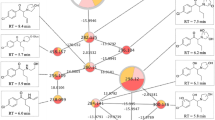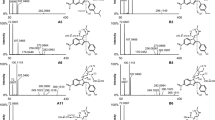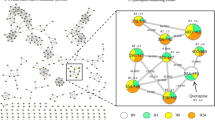Abstract
The recent emergence of new synthetic opioids (NSOs) compounds in the illicit market is increasingly related to fatal cases. Identification and medical care of NSO intoxication cases are challenging, particularly due to high frequency of new products and extensive metabolism. As the study of NSO metabolism is crucial for the identification of these drugs in cases of intoxication, we aimed to investigate the metabolism of the piperazine NSO AP-237 (= bucinnazine). Two complementary approaches (in silico and in vitro) were used to identify putative AP-237 metabolites which could be used as consumption markers. In silico metabolism studies were realized by combining four open access softwares (MetaTrans, SyGMa, Glory X, Biotransformer 3.0). In vitro experiments were performed by incubating AP-237 (20 µM) in differentiated HepaRG cells during 0 h, 8 h, 24 h or 48 h. Cell supernatant were extracted and analyzed by liquid chromatography coupled to high-resolution mass spectrometry and data were reprocessed using three strategies (MetGem, GNPS or Compound Discoverer®). A total of 28 phase I and six phase II metabolites was predicted in silico. Molecular networking identified seven putative phase I metabolites (m/z 203.154, m/z 247.180, m/z 271.180, two m/z 289.191 isomers, m/z 305.186, m/z 329.222), including four previously unknown metabolites. Overall, this cross-disciplinary approach with molecular networking on data acquired in vitro and in silico prediction enabled to propose relevant candidate as AP-237 consumption markers that could be added to mass spectrometry libraries to help diagnose intoxication.





Similar content being viewed by others
Data availability
Some raw data are available in supplementary data.
References
Allard S, Allard P, Morel I, Gicquel T (2019) Application of a molecular networking approach for clinical and forensic toxicology exemplified in three cases involving 3-MeO-PCP, doxylamine, and chlormequat. Drug Test Anal 11(5):669–677
Aninat C, Piton A, Glaise D, Le Charpentier T, Langouët S, Morel F et al (2006) Expression of cytochromes P450, conjugating enzymes and nuclear receptors in human hepatoma HepaRG cells. Drug Metab Dispos 34(1):75–83
Baba S, Morishita S (1975) Studies on drug metabolism by use of isotopes. XVI. Species differences in metabolism of 1-butyryl-4-cinnamylpiperazine hydrochloride. Chem Pharm Bull 23(9):1949–1954
Blanckaert P, Cannaert A, Van Uytfanghe K, Hulpia F, Deconinck E, Van Calenbergh S et al (2020) Report on a novel emerging class of highly potent benzimidazole NPS opioids: chemical and in vitro functional characterization of isotonitazene. Drug Test Anal 12(4):422–430
Brunetti P, Berardinelli D, Giorgetti A, Schwelm HM, Haschimi B, Pelotti S, et al (2023) Human metabolism and basic pharmacokinetic evaluation of AP‐238: a recently emerged acylpiperazine opioid. Drug Test Anal 1–15. https://doi.org/10.1002/dta.3535
Busardò FP, Lo Faro AF, Sirignano A, Giorgetti R, Carlier J (2022) In silico, in vitro, and in vivo human metabolism of acetazolamide, a carbonic anhydrase inhibitor and common “diuretic and masking agent” in doping. Arch Toxicol 96(7):1989–2001
Caccia S (2007) N-dealkylation of arylpiperazine derivatives: disposition and metabolism of the 1-aryl-piperazines formed. CDM 8(6):612–622
Carlier J, Berardinelli D, Montanari E, Sirignano A, Di Trana A, Busardò FP (2022) 3F-α-pyrrolydinovalerophenone (3F-α-PVP) in vitro human metabolism: Multiple in silico predictions to assist in LC-HRMS/MS analysis and targeted/untargeted data mining. J Chromatogr B 1193:123162
Carrano RA, Kimura KK, McCurdy DH (1975) Analgesic and tolerance studies with AP-237, a new analgesic. Arch Int Pharmacodyn Ther 213(1):41–57
Cerec V, Glaise D, Garnier D, Morosan S, Turlin B, Drenou B et al (2007) Transdifferentiation of hepatocyte-like cells from the human hepatoma HepaRG cell line through bipotent progenitor. Hepatology 45(4):957–967
de Bruyn KC, Šícho M, Mazzolari A, Kirchmair J (2021) GLORYx: Prediction of the metabolites resulting from phase 1 and phase 2 biotransformations of xenobiotics. Chem Res Toxicol 34(2):286–299
Di Trana A, Brunetti P, Giorgetti R, Marinelli E, Zaami S, Busardò FP et al (2021) In silico prediction, LC-HRMS/MS analysis, and targeted/untargeted data-mining workflow for the profiling of phenylfentanyl in vitro metabolites. Talanta 235:122740
Djoumbou-Feunang Y, Fiamoncini J, Gil-de-la-Fuente A, Greiner R, Manach C, Wishart DS (2019) BioTransformer: a comprehensive computational tool for small molecule metabolism prediction and metabolite identification. J Cheminform 11(1):2
Dührkop K, Fleischauer M, Ludwig M, Aksenov AA, Melnik AV, Meusel M et al (2019) SIRIUS 4: a rapid tool for turning tandem mass spectra into metabolite structure information. Nat Methods 16(4):299–302
Experimental study on dependence-producing properties of Qiang Tong Ding (AP-237) (2023) | CiNii Research [Internet]. [cited 2023 May 10]. https://cir.nii.ac.jp/crid/1571417124541832064
Ferron PJ, Le Daré B, Bronsard J, Steichen C, Babina E, Pelletier R et al (2021) Molecular networking for drug toxicities studies: the case of hydroxychloroquine in COVID-19 patients. IJMS 23(1):82
Fogarty MF, Vandeputte MM, Krotulski AJ, Papsun D, Walton SE, Stove CP et al (2022) Toxicological and pharmacological characterization of novel cinnamylpiperazine synthetic opioids in humans and in vitro including 2-methyl AP-237 and AP-238. Arch Toxicol 96(6):1701–1710
Gicquel T, Pelletier R, Richeval C, Gish A, Hakim F, Ferron P et al (2021) Metabolite elucidation of 2-fluoro-deschloroketamine (2F-DCK) using molecular networking across three complementary in vitro and in vivo models. Drug Test Anal 14:dta.3162
Guguen-Guillouzo C, Guillouzo A (2019) Setup and use of HepaRG cells in cholestasis research. In: Vinken M (ed) Experimental cholestasis research. Springer, New York, New York, pp 291–312. https://doi.org/10.1007/978-1-4939-9420-5_19 (Methods in Molecular Biology; vol. 1981)
Guillouzo A, Corlu A, Aninat C, Glaise D, Morel F, Guguen-Guillouzo C (2007) The human hepatoma HepaRG cells: a highly differentiated model for studies of liver metabolism and toxicity of xenobiotics. Chem Biol Interact 168(1):66–73
Hassanien S, Layle N, Holt M, Zhao T, Lula D (2023) 2-methyl AP-237. Cayman NPS metabolism monograph [Internet]. https://www.caymanchem.com/product/26485. Accessed 20 Apr 2023
Holman JD, Tabb DL, Mallick P (2014) Employing ProteoWizard to convert raw mass spectrometry data. CP Bioinform [internet]. https://doi.org/10.1002/0471250953.bi1324s46
Hugbart C, Verres Y, Le Daré B, Bucher S, Vène E, Bodin A et al (2020) Non-oxidative ethanol metabolism in human hepatic cells in vitro: involvement of uridine diphospho-glucuronosyltransferase 1A9 in ethylglucuronide production. Toxicol in Vitro 66:104842
Kalgutkar AS, Driscoll JP (2020) Is there enough evidence to classify cycloalkyl amine substituents as structural alerts? Biochem Pharmacol 174:113796
Kessner D, Chambers M, Burke R, Agus D, Mallick P (2008) ProteoWizard: open source software for rapid proteomics tools development. Bioinformatics 24(21):2534–2536
Kirchmair J, Göller AH, Lang D, Kunze J, Testa B, Wilson ID et al (2015) Predicting drug metabolism: experiment and/or computation? Nat Rev Drug Discov 14(6):387–404
Le Daré B, Allard S, Bouvet R, Baert A, Allard PM, Morel I et al (2019) A case of fatal acebutolol poisoning: an illustration of the potential of molecular networking. Int J Leg Med [internet]. https://doi.org/10.1007/s00414-019-02062-9
Le Daré B, Ferron PJ, Allard PM, Clément B, Morel I, Gicquel T (2020) New insights into quetiapine metabolism using molecular networking. Sci Rep 10(1):19921
Le Daré B, Ferron PJ, Couette A, Ribault C, Morel I, Gicquel T (2021) In vivo and in vitro α-amanitin metabolism studies using molecular networking. Toxicol Lett 346:1–6
Litsa EE, Das P, Kavraki LE (2020) Prediction of drug metabolites using neural machine translation. Chem Sci 11(47):12777–12788
Lo Faro AF, Berardinelli D, Cassano T, Dendramis G, Montanari E, Montana A et al (2023) New psychoactive substances intoxications and fatalities during the COVID-19 epidemic. Biology 12(2):273
Malaca S, Busardò FP, Giorgetti R, Huestis MA, Carlier J (2022) In silico prediction, human hepatocyte metabolism, LC-HRMS/MS analysis, and targeted/nontargeted data-mining to characterize 4-acetoxy-N,N-Diisopropyl-Tryptamine Metabolism. Toxicologie Analytique Et Clinique 34(3):S135–S136
McKenzie C, Sutcliffe OB, Read KD, Scullion P, Epemolu O, Fletcher D et al (2018) Chemical synthesis, characterisation and in vitro and in vivo metabolism of the synthetic opioid MT-45 and its newly identified fluorinated analogue 2F-MT-45 with metabolite confirmation in urine samples from known drug users. Forensic Toxicol 36(2):359–374
Morishita SI, Baba S, Nagase Y (1978) Studies on drug metabolism by use of isotopes XX: ion cluster technique for detection of urinary metabolites of 1-butyryl-4-cinnamylpiperazine by mass chromatography. J Pharm Sci 67(6):757–761
News (2019) April 2019 – China: Announcement to place all fentanyl-related substances under national control [Internet]. [cited 2023 May 10]. https://www.unodc.org/LSS/announcement/Details/f2adea68-fbed-4292-a4cc-63771c943318. Accessed 10 May 2023
Observatoire européen des drogues et des toxicomanies (ed) (2020) European drug report: trends and developments. Publications office of the European Union, Luxembourg
Olivon F, Elie N, Grelier G, Roussi F, Litaudon M, Touboul D (2018) MetGem software for the generation of molecular networks based on the t-SNE algorithm. Anal Chem 90(23):13900–13908
Pelletier R, Le Daré B, Grandin L, Couette A, Ferron PJ, Morel I et al (2022a) New psychoactive substance cocktail in an intensive care intoxication case elucidated by molecular networking. Clin Toxicol 60(1):122–125
Pelletier R, Gicquel T, Simoes Eugenio M, Ferron PJ, Morel I, Delehouzé C et al (2022b) A Transversal approach combining in silico, in vitro and in vivo models to describe the metabolism of the receptor interacting protein 1 kinase inhibitor sibiriline. Pharmaceutics 14(12):2665
Pelletier R, Le Daré B, Ferron PJ, Le Bouëdec D, Kernalléguen A, Morel I et al (2022c) Use of innovative, cross-disciplinary in vitro, in silico and in vivo approaches to characterize the metabolism of chloro-alpha-pyrrolidinovalerophenone (4-Cl-PVP). Arch Toxicol [internet]. https://doi.org/10.1007/s00204-022-03427-7
Pérez-Mañá C, Papaseit E, Fonseca F, Farré A, Torrens M, Farré M (2018) Drug interactions with new synthetic opioids. Front Pharmacol 11(9):1145
Ping Y, Jing C, Qing J (2018) Comparison of the use of different analgesics in the course of anesthesia care based on pharmacoeconomics. Pak J Pharm Sci 31(5(Special)):2241–2247
Quesnot N, Bucher S, Gade C, Vlach M, Vene E, Valença S et al (2018) Production of chlorzoxazone glucuronides via cytochrome P4502E1 dependent and independent pathways in human hepatocytes. Arch Toxicol 92(10):3077–3091
Resnik K, Brandão P, Alves EA (2021) DARK classics in chemical neuroscience: bucinnazine. ACS Chem Neurosci 12(19):3527–3534
Ridder L, Wagener M (2008) SyGMa: combining expert knowledge and empirical scoring in the prediction of metabolites. ChemMedChem 3(5):821–832
Rojek S, Poljańska E, Chaim W, Maciów-Głąb M, Bystrowska B (2023) Metabolic evaluation of synthetic opioids on the example of U-47700 with the use of in vitro and in vivo methods for forensic toxicology application. Toxics 11(3):220
Samano K, Clouette R, Peterson DC (2021) Fatality from 2-methyl AP-237 (2-methyl buccinazine), a novel synthetic opioid drug gaining recreational popularity. In: Proceedings of the 2021 Society of Forensic Toxicologists Annual Meeting
Schmid R, Heuckeroth S, Korf A, Smirnov A, Myers O, Dyrlund TS, et al (2023) Integrative analysis of multimodal mass spectrometry data in MZmine 3. Nat Biotechnol [Internet]. 2023 Mar 1 [cited 2023 Apr 6]; https://www.nature.com/articles/s41587-023-01690-2. Accessed 6 Apr 2023
Shannon P (2003) Cytoscape: a software environment for integrated models of biomolecular interaction networks. Genome Res 13(11):2498–2504
Smith HS (2009) Opioid metabolism. Mayo Clin Proc 84(7):613–624
Truver MT, Crosby MM, Gillette AT, Brogan SC, Hoyer JL, Chronister CW et al (2023) Fatal intoxication involving 2-methyl ap -237. J Forensic Sci 68(4):1419–1424
United Nations Office on Drugs and Crime (2021). Drug market trends: cannabis, opioids [Internet]. https://www.unodc.org/res/wdr2021/field/WDR21_Booklet_3.pdf. Accessed 5 Apr 2023
UNODC (2023) Early warning advisory (EWA) on new psychoactive substances (NPS) [Internet]. https://www.unodc.org/LSS/Home/NPS
Wang M, Carver JJ, Phelan VV, Sanchez LM, Garg N, Peng Y et al (2016) Sharing and community curation of mass spectrometry data with Global Natural Products Social Molecular Networking. Nat Biotechnol 34(8):828–837
Wang X, Chang X, Luo X, Su M, Xu R, Chen J et al (2019) An integrated approach to characterize intestinal metabolites of four phenylethanoid glycosides and intestinal microbe-mediated antioxidant activity evaluation in vitro using UHPLC-Q-exactive high-resolution mass spectrometry and a 1,1-diphenyl-2-picrylhydrazyl-based assay. Front Pharmacol 10:826
WHO Expert Commitee on Drug Dependence (2022) Critical review report: 2-Methyl AP-237 [Internet]. https://cdn.who.int/media/docs/default-source/controlled-substances/45th-ecdd/2-methyl-ap-237_draft.pdf?sfvrsn=768c7c03_1. Accessed 30 Mar 2023
Funding
This work was funded by Rennes University to Thomas Gicquel with "Défi Scientifique" grant.
Author information
Authors and Affiliations
Corresponding author
Ethics declarations
Conflict of interest
The authors declare no conflict of interest. The funders had no role in the design of the study; in the collection, analyses, or interpretation of data; in the writing of the manuscript, or in the decision to publish the results.
Additional information
Publisher's Note
Springer Nature remains neutral with regard to jurisdictional claims in published maps and institutional affiliations.
Supplementary Information
Below is the link to the electronic supplementary material.
Rights and permissions
Springer Nature or its licensor (e.g. a society or other partner) holds exclusive rights to this article under a publishing agreement with the author(s) or other rightsholder(s); author self-archiving of the accepted manuscript version of this article is solely governed by the terms of such publishing agreement and applicable law.
About this article
Cite this article
Pelletier, R., Bourdais, A., Fabresse, N. et al. In silico and in vitro metabolism studies of the new synthetic opiate AP-237 (bucinnazine) using bioinformatics tools. Arch Toxicol 98, 165–179 (2024). https://doi.org/10.1007/s00204-023-03617-x
Received:
Accepted:
Published:
Issue Date:
DOI: https://doi.org/10.1007/s00204-023-03617-x




